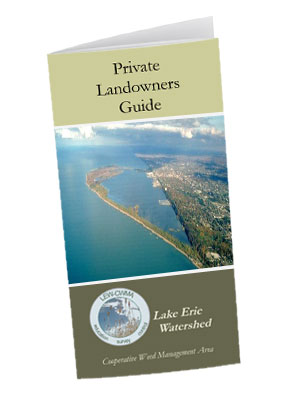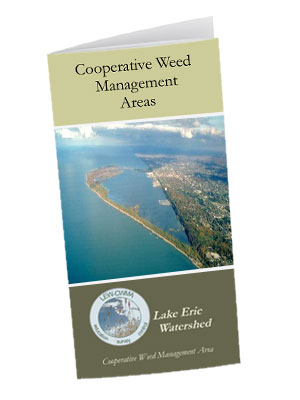Conservation Science
Protecting Pennsylvania’s Plants and Animals
Cooperative Weed Management Areas
The Western Pennsylvania Conservancy is a member of three of the four Cooperative Weed Management Areas (CWMAs) in Pennsylvania. These partnerships bring together county, state and federal agencies, NGOs, businesses and landowners who are interested in raising awareness about invasive species and taking action to control their spread. Of these three CWMAs, WPC is most closely involved in the Lake Erie Watershed CWMA (LEW CWMA).
CWMAs are partnerships with one partner often serving in a coordinating role. WPC is also a member of the Sinnemahoning Invasive Plant Management Area and the Southern Laurel Highlands Plant and Pest Management Partnership. PA Sea Grant supplies a coordinator for the LEW-CWMA.
Gull Point Restoration
At the very tip of Presque Isle State Park sits an area known as Gull Point. The federally endangered piping plover commonly nested here until the mid-1960s. These small shorebirds rely on open, sandy habitat to properly camouflage their nests from predators. Over several decades, growth of woody and invasive species rendered the plover’s traditional nesting grounds undesirable. The Great Lakes portion of the plover’s population is the smallest of the three main populations in the U.S. with fewer than 100 breeding pairs. We hope the restoration of Gull Point habitat will make a significant contribution to the recovery of the species.
Since 2012, LEW-CWMA partners have worked on the restoration of critical habitat at Gull Point for the piping plover. The U.S. Fish and Wildlife Service, PA Bureau of State Parks (BOSP), PA Game Commission, the Pennsylvania Audubon Society and WPC worked together to restore open habitat. After initial treatments that involved clearing of vegetation and application of herbicide, WPC and BOSP continued to inspect and treat areas.
In 2016, male plovers were sighted at Gull Point exhibiting mating behavior (scraping, stone throwing and calling) but no females responded. But in 2017, a male plover appeared and shortly thereafter a female arrived. While that pair bonded and mated, another male and female took up residence. Both pairs laid eggs. The first pair successfully hatched and fledged two chicks. The second pair had to abandon their nest when the already high water rose higher. Fortunately, PGC biologists rescued the submerged eggs. A Michigan rearing facility successfully incubated and hatched the eggs. Those young birds were tagged and released to become part of the Great Lakes piping plover population.
Open habitat at Gulf Point is in better condition than it has been for many years. The birding community will continue watching and hoping that the next year and the years following will put Presque Isle back on the map as piping plover breeding grounds.
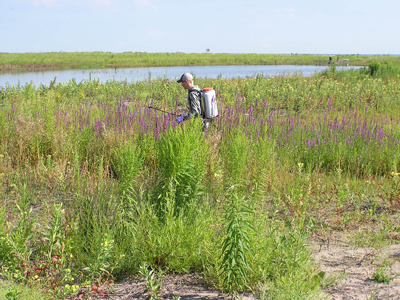
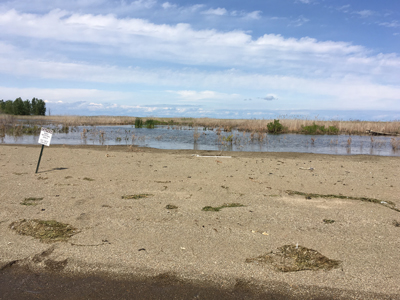
LEW-CWMA Projects
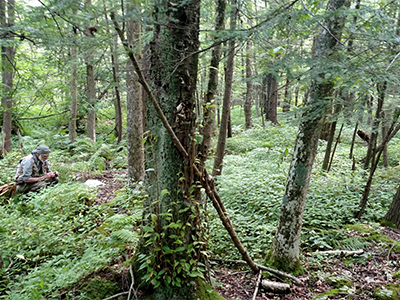 The Great Lakes Restoration Initiative launched in 2010 to tackle the long-standing problems and emerging challenges that must be addressed to revitalize the Great Lakes ecosystem. The control of invasive species and restoration of habitat to protect native species are major focuses of this program. The LEW-CWMA received funding through the Great Lakes Restoration Initiative for a number of years, which has allowed work to happen on several fronts. Pennsylvania Sea Grant created signage, published guides like the Mid-Atlantic Field Guide to Aquatic Invasive Species and engaged in many outreach events.
The Great Lakes Restoration Initiative launched in 2010 to tackle the long-standing problems and emerging challenges that must be addressed to revitalize the Great Lakes ecosystem. The control of invasive species and restoration of habitat to protect native species are major focuses of this program. The LEW-CWMA received funding through the Great Lakes Restoration Initiative for a number of years, which has allowed work to happen on several fronts. Pennsylvania Sea Grant created signage, published guides like the Mid-Atlantic Field Guide to Aquatic Invasive Species and engaged in many outreach events.
The PA Bureau of State Parks assembled crews of interns that spent their summers treating invasive plants on Presque Isle State Park. WPC funded a coordinator for the CWMA and continues to work with the CWMA partners to prioritize and treat invasive plant species in ecologically valuable areas within the watershed.
The LEW-CWMA has undertaken several dozen invasive species control projects oriented around the conservation of high-value ecological areas, also called Natural Heritage Areas (NHAs). These NHAs were identified in the 2012 update of the Erie County Natural Heritage Inventory. The LEW-CWMA will continue to identify new areas and landowners to work with, and raise awareness and interest among the residents of Erie and Crawford counties.
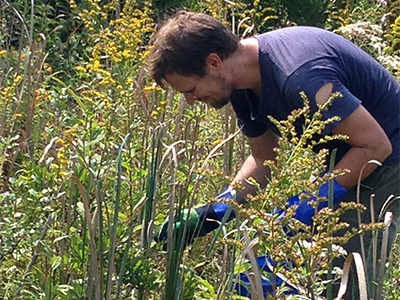
Although quite small, we recently worked at the unique, calcareous wetland -Mercyhurst Fen, owned by Mercyhurst University. This sensitive wetland habitat is home to a number of rare plants, making it sensitive to invasive plant species. WPC assembled a crew to hand pull and treat invasive plants like narrow-leaved cattail (Typha angustifolia), common reed (Phragmites australis), coltsfoot (Tussilago farfara) and bush honeysuckle (Lonicera macki and L morrowii).
In contrast, our work at State Game Lands 314 in Erie County involved the treatment of acres of invasives, most notably European black alder (Alnus glutinosa). This large-growing shrub can form monocultures and take over entire habitats. To stop its spread, we cut and treated a large stand of the tree.
The goal of our work is seldom to eliminate all invasive species, which would be difficult, costly and likely impossible. Our main goal is to keep important areas from being overrun by invasive species and to maintain viable populations of both rare species and more common native vegetation, as well as the overall character of these natural places.

